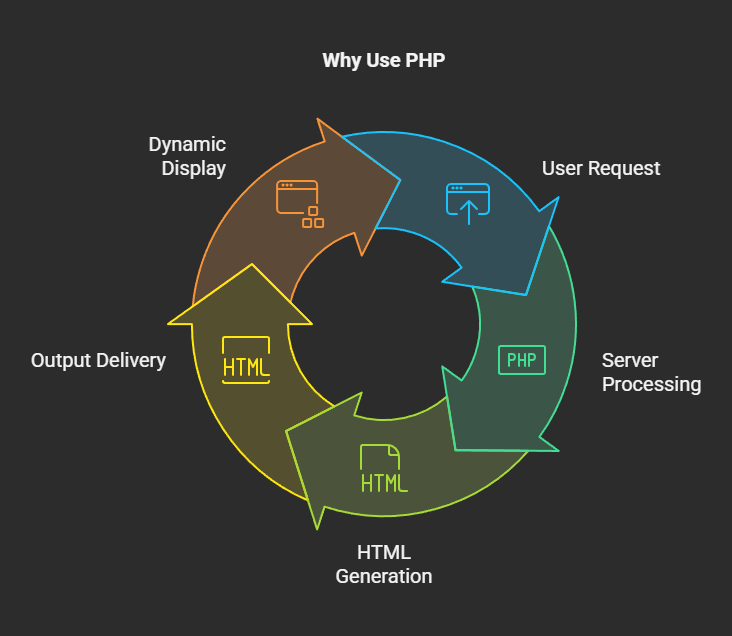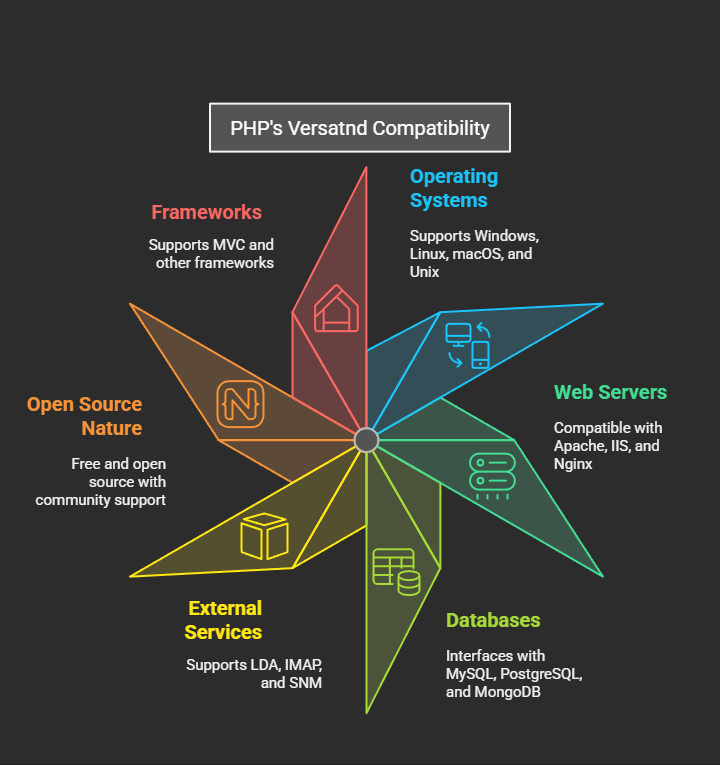Why Use PHP
The PHP is a popular scripting language for online development. The sources said its appeal stems from its strong yet easy-to-use tool for creating dynamic online content for developers and businesses. Originally representing Personal Home Page Tools, the acronym PHP has now changed to its current recursive form, Hypertext Preprocessor.

PHP’s essential function as a general-purpose scripting language and interpreter that is freely available to developers is one of the main causes of its widespread adoption. Even while server-side scripting is its primary purpose, it may also be used for command-line scripting and, to a lesser extent, desktop applications.
The server-side scripting capabilities of PHP are its main advantage for web development. The web server processes a request from a user’s browser when they visit a webpage using PHP script. Most importantly, PHP and a PHP parser (either a server module or a Common Gateway Interface (CGI) parser) must be installed on the web server.
The web server executes the PHP script prior to sending the document to the client browser. The parser carries out the script’s stated actions by interpreting the PHP code contained in the page. These processes subsequently produce Hypertext Markup Language (HTML) as their output. Together with any other standard HTML that may already be on the page, this generated HTML is delivered to the client browser, enabling a smooth display of the content.
PHP scripts are used in this procedure to create dynamic HTML pages. In contrast to static pages, which have fixed content, dynamic pages might have material that changes depending on how the script interprets the page each time it is accessed. The capacity to create content instantly depending on data, logic, or user interaction is a major benefit of developing websites with a language like PHP.
Because PHP integrates with common web technologies, working with it for server-side scripting is simple. A PHP script may be the sole component of a webpage, or it may be embedded within other HTML elements. The.php file extension is usually applied to the webpage file to indicate to the web server that it includes PHP code.
A basic illustration of an HTML page with an embedded PHP script, test.php. This sample illustrates the marking out of PHP code inside a file. PHP scripts must be enclosed in the start and end tags at all times. The portions of the page that must be processed by the PHP parser are explicitly indicated by these tags.
Two variables are defined by the PHP script in the example code that is provided: $text and $date. “This is a test HTML script.” is the simple string value stored in the $text variable. The current date, which is obtained using the built-in date function, is allocated to the $date variable. These variable definitions are followed by an echo statement.
The output of content to the page is done with the echo command. Here it concatenates the contents of the $date variable, the contents of the $text variable, and some more text. When PHP wants to concatenate (connect together) numerous components, it employs a period (.). Additionally, the example illustrates how PHP output may be seamlessly integrated with HTML by using typical HTML syntax, like and for bold text, within the echo line.
When a browser reaches this test.php page, the embedded script is processed by the PHP parser and web server. The parser runs the script, establishes the variables’ values, joins the strings, and adds the date’s bold formatting. After that, the PHP script’s output is sent back to the browser as standard HTML. An explanation of the Google Chrome-displayed webpage that displays the PHP script’s generated text beneath the main header.
It runs on many operating systems
The PHP’s excellent compatibility with many platforms and systems supports its broad adoption. Most popular operating systems, including Windows, Linux, macOS, and Unix, support PHP. Developers can install PHP on any server configuration and use it in any environment because it works with so many operating systems.

Also compatible with PHP are the majority of web servers available today, including Apache and Microsoft Internet Information Services. In a title on configuring PHP also make reference to Nginx. With this interoperability, PHP applications can run on widely used, well-supported server software. PHP has the ability to interface with a broad range of database platforms in addition to operating systems and web servers. Examples from the include IBM Db2, dBase, PostgreSQL, MongoDB, MySQL, and SQLite3. In order to store and retrieve data, dynamic web applications require this broad database functionality. PHP may communicate with external services by supporting LDA, IMAP, and SNM.
PHP’s free and open source nature boosts its appeal. PHP can be used by developers and organisations without incurring license fees. Open source software like PHP is available on GitHub, encouraging community participation. PHP is licensed under PHP License 3.01. PHP can be used in source and binary formats, with or without changes, under this license, with some recognition and copyright notice requirements. ASP.NET, Microsoft’s open-source web framework, is often compared to PHP. The PHP programs can be used on webpages alongside HTML, like ASP.NET.
The PHP 8.2.3, released in February 2023, was the latest version. You mentioned PHP 7+’s performance increases, however your extracts don’t describe its features or performance. Development can range from small jobs to huge apps using frameworks like MVC. In order to emphasise PHP’s versatility, the sources also state that it is for “more than just the web”. Its designation as a “general-purpose” language and its support for several environments suggest some flexibility, but they don’t clearly address how it handles large-scale applications or support for frameworks like MVC.
In conclusion
The emphasise PHP’s appeal as a popular, open-source, and free general-purpose scripting language, mainly for web development. Its main purpose is to use server-side scripting to cooperate with web servers and parsers to create dynamic HTML content. Using certain elements and file extensions, PHP scripts may be readily integrated into HTML, making integration simple. Because it works with so many different database platforms, web servers, and main operating systems, it is a very adaptable and deployable solution for many online projects. When taken as a whole, these elements greatly contribute to PHP’s continued popularity in the web development industry.
